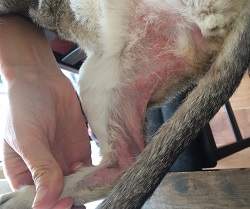At a glanceAbout: Bald spots are a common symptom in cats and can range from one small isolated patch to multiple bald patches or widespread baldness. Causes:
Diagnosis: Baseline tests, skin scrapings, biopsy, histopathology or cytology, culture. Treatment: This will depend on the underlying cause. |
About
Bald spots are a common occurrence in cats, they can affect many parts of the body for any number of reasons.
Hair loss can be in one small area, such as an abscess, multiple lesions (ringworm), or large patches of hair loss with conditions such as psychogenic alopecia, hyperthyroidism and Cushing’s syndrome. Bald spots may be well defined, or areas of patchy hair.
Flea allergy dermatitis
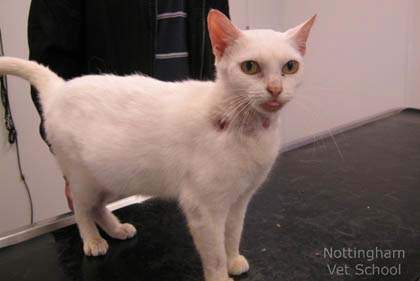
An extremely common and frustrating condition in which your cat becomes hypersensitive to the saliva of the flea. A localised reaction occurs.
Symptoms:
Lumps and bumps (particularly close to the tail), scabs around the neck, and thinning to bald patches of fur.
Itching, scratching, biting and licking the area are common.
Treatment:
Flea treatment to kill the fleas on your cat, steroids can be given to help control the pruritis and allow your cat to heal. Antibiotics to treat a secondary infection.
As 90% of the flea life cycle is spent in the environment, it is necessary to treat the home too. Vacuum daily, and use an insecticide to kill eggs larvae and pupae.
Abscess

An abscess is a walled-off collection of pus under the skin which is usually caused by a bite wound. Cats who are allowed to roam outside, especially male cats, are at the greatest risk due to a higher incidence of territorial fighting.
Symptoms:
A warm lump will be felt just under the skin, hair loss may occur over the affected area, if the abscess ruptures, a foul-smelling discharge will ooze out. The head, neck and shoulders are the most common locations.
Treatment:
If the abscess hasn’t ruptured, it will be lanced, drained, and packed with antibiotics. The cat will be discharged with a course of oral antibiotics.
Ringworm
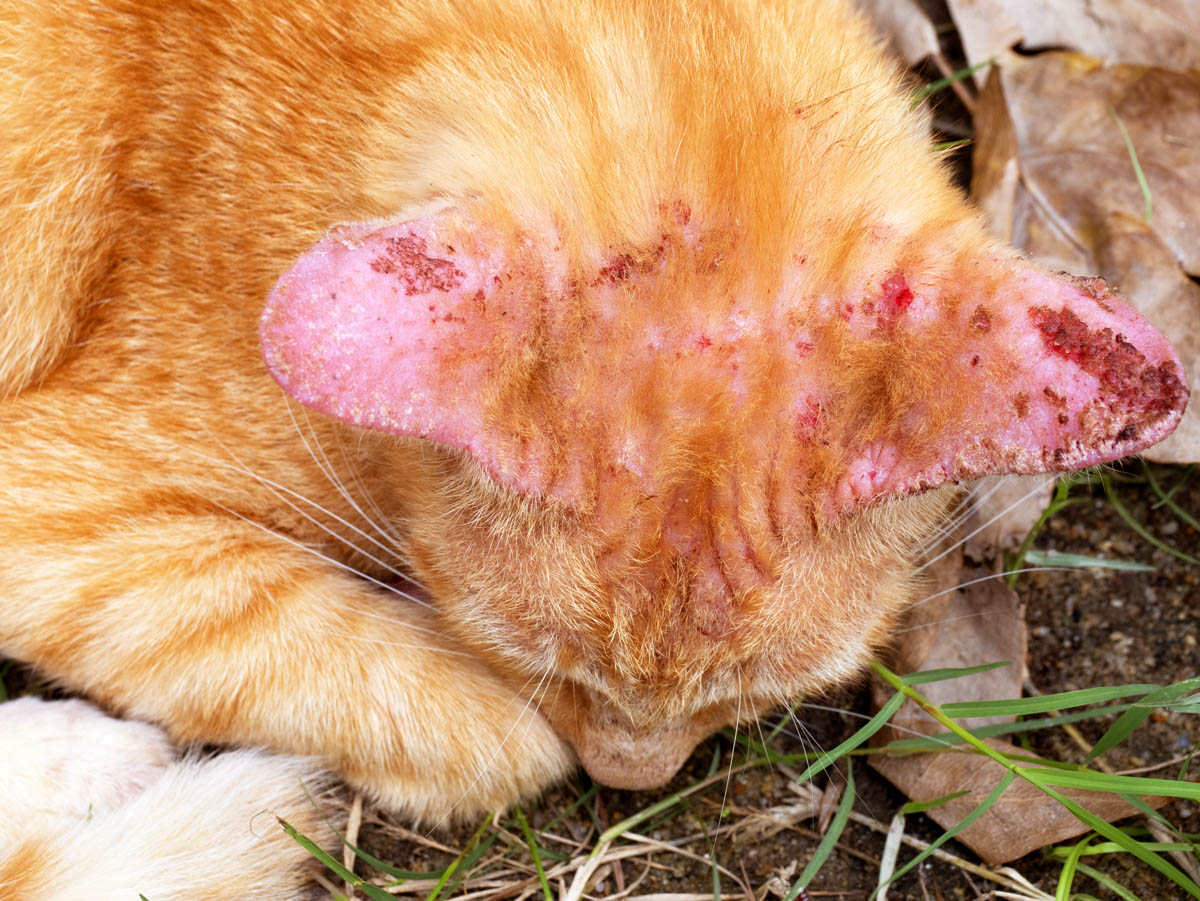
A highly contagious fungal infection of the skin and claws occurs most often in young cats, immunocompromised cats and stressed cats in crowded conditions. Ringworm is zoonotic, which means it is possible to spread from cats to humans and other pets.
Symptoms:
Circular, scaly red lesions start out small and increase in size. Areas of hair loss.
The head, ears and tail are the most commonly affected areas.
Treatment:
Medicated shampoos and dips and medication (Griseofulvin or Itraconazole) to inhibit the growth of the fungus. It may be necessary to clip longhaired cats prior to treatment.
Environmental decontamination is also necessary with a 1:10 bleach solution.
Psychogenic alopecia
Over-grooming is a stress-related disorder and can be classified as obsessive-compulsive behaviour (similar to nail-biting or hair-pulling in people. When the cat engages in obsessive behaviour, endorphins (hormones which make the cat happy) are released, which makes the activity a pleasurable and relaxing pursuit. During times of stress, the cat grooms in an attempt to relieve these feelings.
Symptoms:
The cat licks and bites the fur beyond what is normal which can ultimately cause areas of hair loss. The hind legs and torso are the most common locations.
Treatment:
Find and treat the cause along with keeping your cat’s routine the same, and providing him with plenty of attention and enrich the environment with interactive toys, scratching posts, perches and plenty of stimulation.
Anti-anxiety or antidepressants may be necessary to treat severe cases of psychogenic alopecia.
Food allergy
Food allergies are the third most common type of allergy in cats (behind flea allergy and inhalant allergy). The most common causes of food allergies are fish, beef, chicken, eggs, and wheat. Cats become allergic to foods they have eaten for a long period of time (usually two years or more). There is no breed, sex or age predilection. Cats with other allergies (such as inhalant) may be at greater risk of developing food allergies. There appears to be a genetic component. Cats can develop allergies to proteins in their food, it can develop at any age.
Symptoms:
- Nonseasonal itching, especially on the front half of the body, head, face, ears, and neck
- Feline acne
Miliary dermatitis
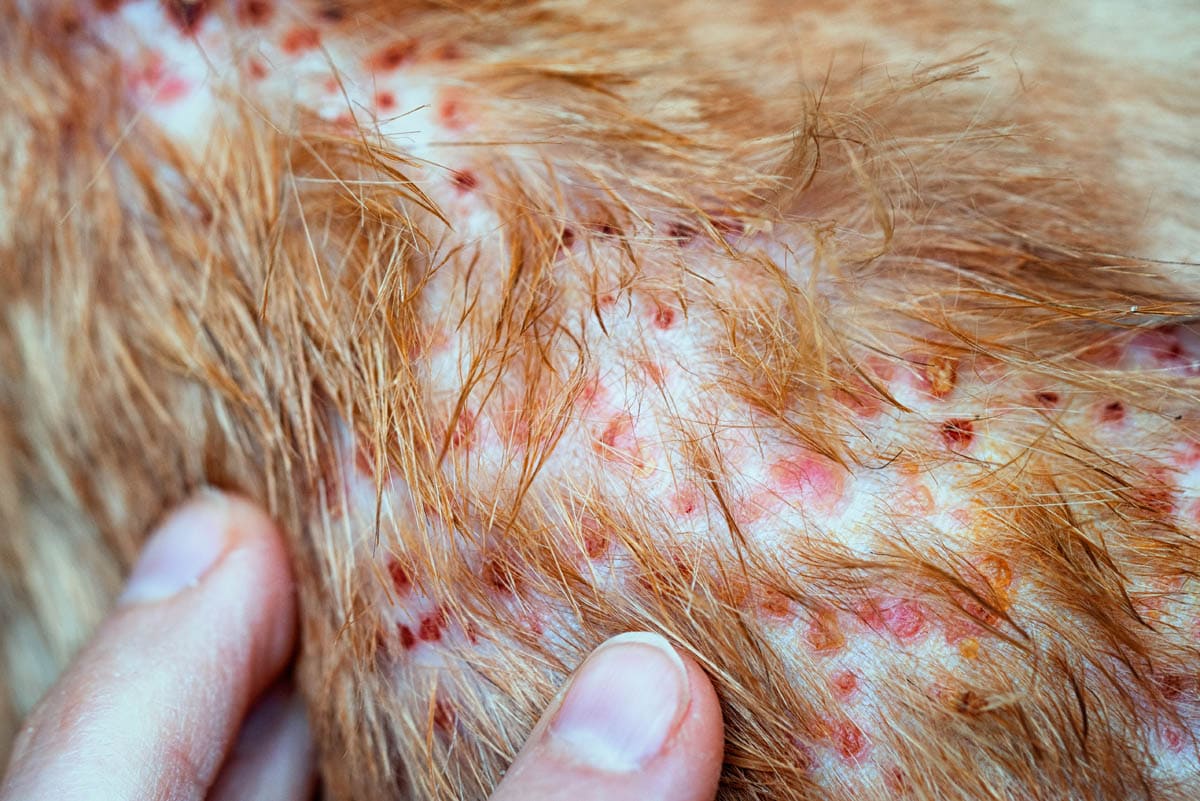
Miliary dermatitis (also called miliary eczema, papulocrusting dermatitis or scabby cat disease) isn’t a specific disease but a disease complex. It is characterised by a red and crusty rash around the head, neck, and back, which is intensely itchy.
Symptoms:
- Red, crusty bumps and papules, especially around the head, ears, neck, and back (dorsal), often with intense itching.
- As the head and neck areas are within reach of the claws, scratching can lead to self-trauma, resulting in large and often open scabs (excoriations).
- Hair thinning or loss around the affected area.
- Scratching, licking and biting the affected area.
Treatment:
- Diligent flea control on both the cat and in the environment.
- Dips, medicated shampoos, topical treatments and oral medications to treat mites, mange, fungal and yeast infections.
- Anti-parasitic medications to kill intestinal parasites.
- Hypoallergenic diet for cats with food allergies. Some cats can go on to develop an allergy to the new diet.
- Avoidance (where possible) if other non-food related allergies are the cause.
- Antibiotics for secondary skin infections, if required.
Skin parasites
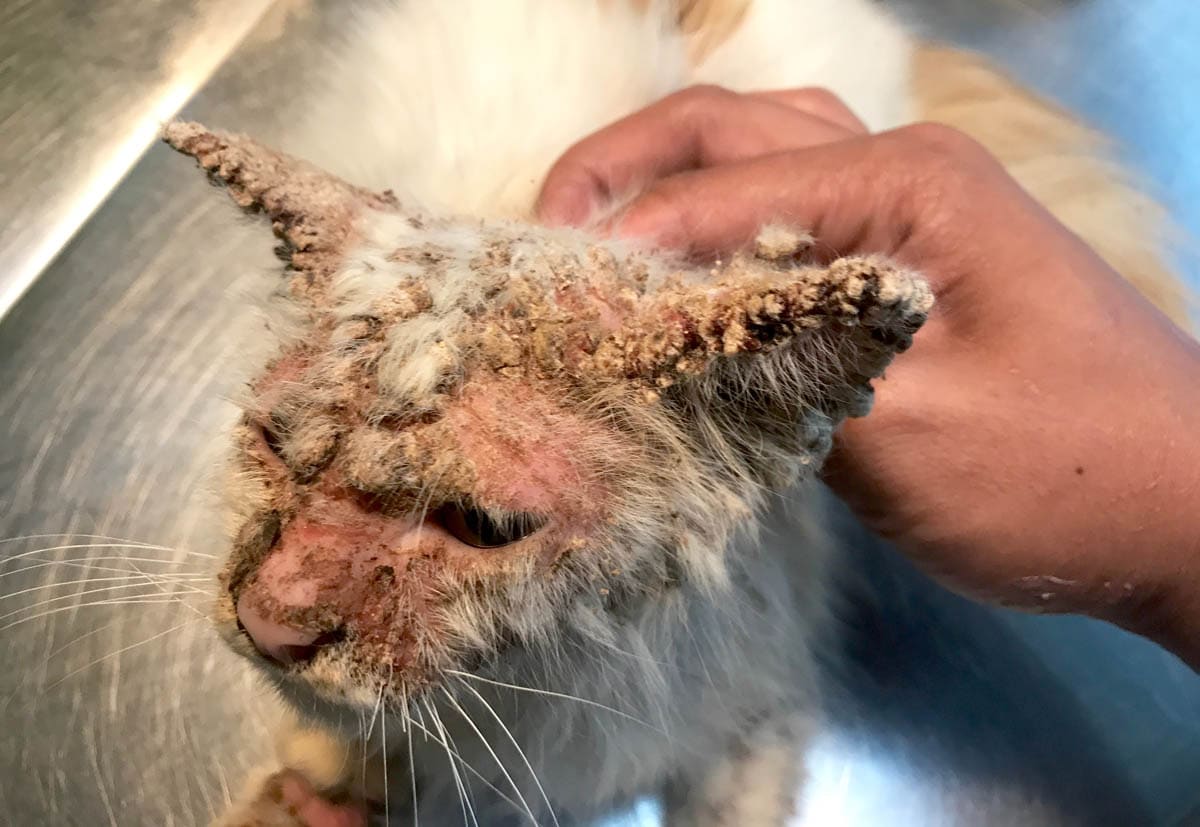
Fleas, mites and ticks can cause intense itching, which leads to over-grooming and hair loss in many cats.
Symptoms:
Scratching, grooming more than normal, biting the area, hair loss or thinning, thickened or inflamed skin, scabs and crusting.
Treatment:
Topical or oral medications to kill the parasites. Treat all pets in the household and wash bedding thoroughly. Vacuum to remove parasites in the environment and use a suitable insecticide to kill parasites in the home.
Antihistamines or corticosteroids may be prescribed to relieve itching.
Feline acne
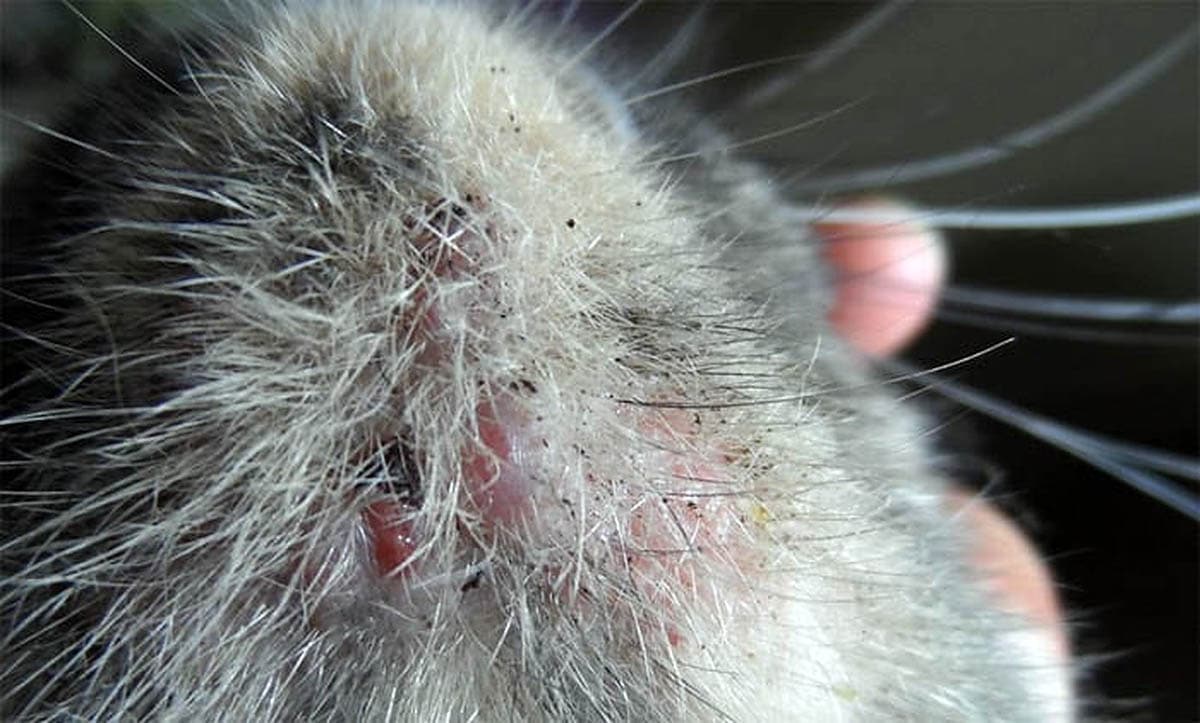
Blackheads form on the chin of affected cats. The area can become inflamed and infected (folliculitis). Feline acne is associated with the use of plastic bowls, hormonal imbalances, stress, allergies, overactive sebaceous glands and chin rubbing.
Symptoms:
The hair on the chin becomes thin/sparse, blackheads form and over time the area can look red, sore and ooze. Secondary bacterial infection can develop.
Treatment:
Keep the area clean with diluted chlorhexidine or Betadine (iodine). Switch to glass or stainless steel food and water bowls, which should be washed once a day. Glucocorticoids may be necessary to reduce inflammation.
Folliculitis
Folliculitis is an inflammation or infection of the hair follicles characterised by the presence of red bumps on your cat’s skin. The condition occurs when bacteria, which normally reside on the skin invade the hair follicle, usually due to damage caused by itching, scratching or inflammation. Feline acne, allergic dermatitis, mites, metabolic disorders, flea bite allergy and stud tail can both lead to folliculitis in the cat.
Symptoms:
- Red or pus-filled papules on around one or more hair follicles. Small fissures or ulcers can develop in severely affected cats. The fur may become thin, with bald patches.
- If feline acne is present, the follicles may contain blackheads, with surrounding skin red and inflamed.
- Itchiness.
- Localised lymph node swelling.
Treatment:
Find and treat the underlying cause which may include steroids to reduce inflammation and itching and antibiotics for bacterial infection.
Squamous cell carcinoma
This is a type of skin cancer due to sun exposure. Tumours can occur on any part of the body, but the head is the most common area. White cats or cats with white patches are particularly vulnerable to developing SCC.
Symptoms:
- Small raised red dots on the affected area which slowly increase in size into scaly red patches which crust and bleed
- Non-healing sores on the nose or face
- Scabs along the ear margins which may ulcerate
- Itching
- Hair loss in the affected area
- Sneezing
- Tissue erosion is common as the tumour progresses into the deeper tissue layers
Treatment:
- Surgery: Surgical excision with a wide margin, in advanced cases, not only will the tumour be removed due to the invasiveness of this type of cancer but underlying tissue may also be removed, including the ear, nose or jawbone. For cats with oral SCC, the closer towards the front of the lower jaw, the better the outcome. Tumours further back in the mouth or occurring in the upper jaw are harder to remove.
- Cryosurgery: This treatment kills the cancerous cells by freezing them with liquid nitrogen.
- Electrochemotherapy: An emerging therapeutic treatment that shows great promise for the treatment of skin tumours. Chemotherapy drugs are poorly absorbed, this treatment allows for better penetration by delivering electric pulses into the tumour after administration of chemotherapy.
Basal cell tumour
Basal cell tumours are slow-growing. They may be benign (basal cell tumour) or low-grade malignant (basal cell carcinoma), thankfully, 90% of basal cell tumours in cats are benign. Malignant basal cell carcinomas rarely metastasise (spread to other parts of the body).
Symptoms:
Benign basal cell tumour:
- Firm, solitary, well-defined, hairless bumps which can range in size from 0.2 cm to 10 cm
- Dark pigmentation of the lump is common
- Ulceration and secondary infection can develop
Basal cell carcinoma:
- Unlike benign basal cell tumours, basal cell carcinomas are often flat and ulcerated, they can spread to surrounding skin, forming new ulcers
Treatment:
The goal of treatment is to remove the tumour.
- Surgery with a wide margin for benign tumours or a wide margin for malignant carcinomas is the mainstay of treatment for basal cell tumours.
- Cryosurgery (freezing) for tumours that are less than 1 cm in diameter.
- Radiotherapy as a follow up if it is not possible to remove the tumour with a wide enough margin.
It is possible for tumours to return, which will require additional surgery.
Topical medications
Certain topical medications such as those used to treat fleas can cause hair loss in cats. If the area of hair loss becomes inflamed or your cat experiences other symptoms, please seek veterinary care.
Symptoms:
Areas of hair loss, which can be painful and inflamed.
Treatment:
Wash the product from your cat, antiseptics to treat the wound and if necessary antibiotics. Use another form of medication in the future.
Vaccine reaction
From time to time, some cats can develop a bald spot where they have had a vaccination. The hair grows back over time. Keep an eye on the area and check for a lump under the skin. If it grows in size or is still there after 4-8 weeks, seek veterinary attention.
Symptoms:
Areas of hair loss at the injection site.
Treatment:
Usually, no treatment is necessary and hair will grow back in time.
Hyperthyroidism
Feline hyperthyroidism is a common disease caused by a benign hormone-secreting tumour of the thyroid gland. It is the most common endocrine disorder in cats and occurs most often in cats over ten years of age.
Symptoms:
- Weight loss
- Increased appetite
- Palpable thyroid gland
- Diarrhea
- Vomiting
- Increased thirst and urination
- Behavioural changes such as nervous/jittery behaviour, aggression, over-grooming and or bald patches, hyperactivity and increased vocalisation
- Rapid heartbeat (tachycardia)
- Rapid, shallow breathing (tachypnea)
- Poor coat condition
- Thickening of the claws
- Hypertension
Treatment:
Radioactive iodine to kill the tumour, surgery to remove the tumour provide a cure, or a prescription diet to manage the disease.
Cushing’s syndrome
Cushing’s syndrome (hyperadrenocorticism) is an endocrine disorder caused by high levels of cortisol in the body either due to a tumour or medical administration of corticosteroids. It is a rare disease in cats and occurs most often in middle-aged to senior cats.
Symptoms:
Areas of bilateral, symmetrical hair loss, increased thirst, and urination, enlarged abdomen, muscle wasting, thin skin and lethargy.
Treatment:
Surgical removal of the adrenal gland if a tumour is present, or gradual withdrawal of medications.
Eosinophilic granuloma complex
This is a group of skin lesions affecting different parts of the body. Due to the infiltration of cells known as eosinophils, which are white blood cells that usually attack parasites. The condition is believed to be caused by allergic reactions (for example flea bites), food hypersensitivity or inhalant allergies. It can affect many parts of the body.
Symptoms:
Lesions can appear on any part of the body, but most often develops on the abdomen or thighs. They appear as red, well-defined, raised, hairless lesions which may be ulcerated.
Treatment:
Find and eliminate the allergen if possible, along with steroids to reduce inflammation, and in severe cases, immunosuppressive drugs. Surgical excision may be necessary if lesions do not heal.
When are bald spots normal?
A recent search term caught my eye, with a visitor looking up information on a bald spot on their cat’s belly. Now, we already know there are a number of causes of bald spots, but there are also a number of bald spots which are normal.
Anus: Obviously it makes sense for this part of the body to have no fur so the area doesn’t become clogged with feces.
Nipples: Cats have eight nipples in two rows of four. Both male and female cats have nipples.
Belly button: The fur hides the belly button on most cats although cats. However, if you look carefully, the belly button can be seen as a small, round area in the middle of the belly that has no fur.

Other parts of the body have fur, but it is less dense. Areas include in front of the ears, the inside of the ears and the belly, particularly towards the hind legs as well as the inner hind legs. It should be noted that these areas are also commonly affected by certain conditions such as allergies, dermatitis and over-grooming, as they are easier to reach when an itchy cat is grooming. Below is an image of a cat with severe contact dermatitis, which presented with areas of hair loss on the hind legs and redness.
